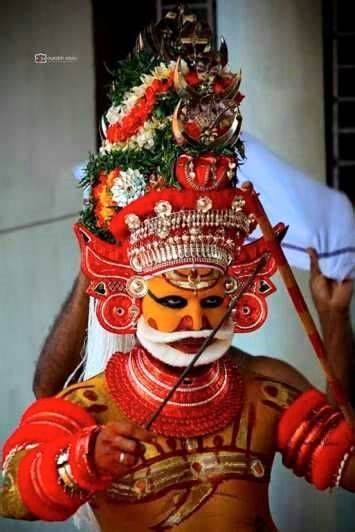

When talking about Perumas, the people of North Malabar always talk about Theiya Perumas. How can they forget the tea leaves that are indispensable in their lives? Every person from North Malabar holds the hand of these tea sticks and shares their feelings right from their childhood when life is sad or happy.
When God descends from the idols and becomes living kolams, when the upper caste stands in the stables with the reward of fear and devotion to the theyams tied by the lower caste, then the theyam is a social revolution. There takes place the mental revolution brought about by the interaction between gods and men. It has to be experienced beyond mere reading. For some theyam is a ritual, for others it is an art form!!
Theyam is the concept of a dancing deity. The dance of Theiyat is called Theiyattam, Thirayattam or Kaliyattam and the costume of Theiyat is called Theiyakolam. 'Theyam' is another form of the word God. Care is taken to wipe away the tears of devotees, to soothe their pains, and to perform the Theyam in the villages. Their sorrows are 'remedied' by rice, and they become self-experiential as their favorite prasadam, a sublime art form. In this way the crops are protected, the country is protected, diseases are removed and theyam evolves into the pulsating pulse of the country and its people.
It is generally said that Theyam is known as Theyam from Pasihangadi to Valapatnam, Kaliyattam to the north of the Pasihangadi river, and Thirayattam from Valapatnam to the south, but the area from Pasihangadi to Valapatnam itself is described as Kaliyattam. For example, the Teyolsavam at Anthur Kav near Parassinikadav is known as Kaliyattam.
When we know that the practice of Theyam is thousands of years old, we will surely inquire about its origin. It comes in Sangha period. Back then it was known as “Velan Veriattam”. The “Chilapathikara” of Ilankovadis, an important Sangha period work, contains references to art forms like Kumarikolam and Velan Veriat.
Although there is no clear indication of Velan Veriyattam as an art form, there are indications in Sangha period literary works that ritual dances were performed under this name based on fire. It is the attam used by individuals decorated with natural materials to maintain their faith. Even today, tea leaves are still used as natural products.
Natural materials such as Chailyam, Manayola, Thirimashi, Anjanam, Lime etc. are still used for writing on the faces of Theiyams. All the decorations are done in Kuruthola. There have been no major changes in Theiyattam from the old system of 'the counterparts of their worshiping murthys according to the local customs and according to God's will, Uranjadi is a place of refuge for the believers'. I do not pretend not to see that there have been some modifications here and there in accordance with the times.
It is believed that the ``Manakadan Gurus'' were given a new look and shape to this art form which was visualized in completely unscientific practices during the reign of "Sri Vallabhan" Kolathiri king under his instructions. Along with this, it is said that a person named “Chalay Perumalayan” gave new forms to the Theiyams. It should be checked. It is said that he was the one who gave Kuttichatan the form to strangle Theiya. The Kolathiri dynasty extended from Chandragiripuzha in the north to Korapuzha in the south. It can be said that there was no other dynasty that promoted Theiya more.
Born in the Vannan community of Karivellur, Manakkadan Gurukal was a great magician and master of arts. The King of Kolathiri, Sri Vallabhan, who heard about him, invited the Gurus to Chirakkal Kovilakam and conveyed his wish. As a result, in a single night, in the dream vision of King Kolathiri, some forty (39) Theiyakolams were teased. "One Kure Nalpat" Theiyams are celebrated in connection with the art culture of Kolaswarupa (Kolathiri King) and Allada Swarupa (Neeleswaram King).
Many of the thottam songs that preceded the arrival of the Theiyakolams to the scene have references to some forty Theiyas. In the Kundora Chamundi defeat, "Shri Mahadeva Thiruvadi Nallachan is good enough to defeat one or forty of them" and "one or forty Vanakans" in the Panans' Vazurimala defeat, and "one or forty with him" in the Bhadrakali defeat.
But in today's Theiyam presentation, the said forty Theiyakolams are not seen tied up and instead thirty-five Theiyams according to the "Peetha" myth and their sub-categories are seen tied and worshipped. Twenty-nine Theiyams where Kolam was ordered and tied and six Theiyams that were not tied with Santha Peetha were added later, Wayanatukulavan, Cheerma Bhagavathy, Kundora Chamundi and Kurathi, which became about forty.
At the end of every Theiyam, before sitting on the wooden peetha in Kavinmuttam, you can hear them exclaiming about the peethas ordered by 'Cheraman Perumal'. For example: "......a Peetha has been bent for me as well, because I do not bend in the path." It is customary to say this peethavasam before the Theiyam sits on the peetha. The peeths are Aimpadi Chitra Peetham (Samoothiri Nadu), Pallichitra Peetham (Kolathiri Nadu), Madian Chitra Peetham (Kanhangad-Nileswaram) and Kumbala Chitra Peetham (Kumbala-Maippadi Swarupam).
The names of those thirty Taivartheiyas mentioned in the Arulapad and hymns of the Theiyakolams are: "Mubinal Tampuran Bantrakolapan (Perum Trikovilappan), Taiparadevata, Kalariyal Bhagavathy, Someswari, Chuzhali Bhagavathy, Patikkutty Amma, Vayathur, Kaliyar, Keezhur Shastav, Keezhur Vairajathan (Vairajathaneswaran), Tien temple guardian, Veerabhadra, Mahaganapati, Yaksha, Yakshi, Kuttishasta, Urpachachi (Oorpachachi), Vettakarumakan, Alamkarumakan, Putruvadichekavar (Virgin's son), Bammurikan, Karimurikan, Southern Cariathan, Wayanatukulavan, Thotumkara Bhagavathy, New Bhagavathy, Veerer Kali, Bhadrakali, Vishnumurthy, Rakteshwari, Raktakhamundi, Uchitta, Kariwal (Karuwal), Kandakarnan and Veeran” are the thirty-five Theiyams.
(to be continued...)